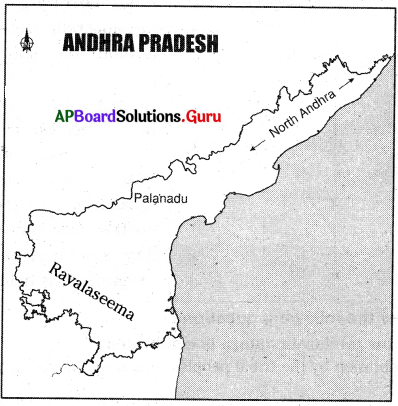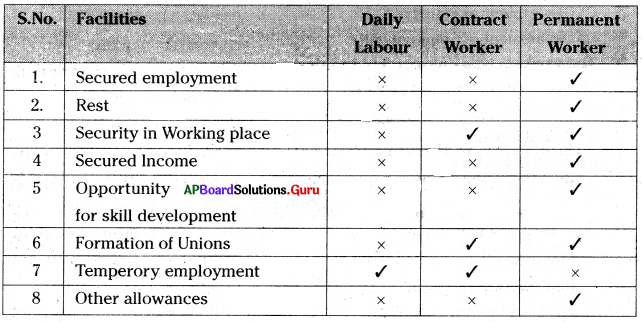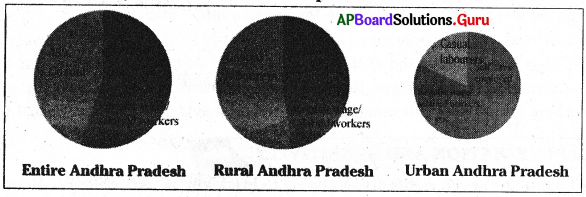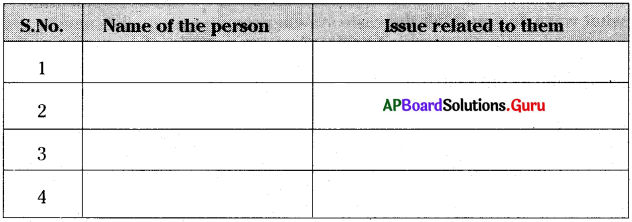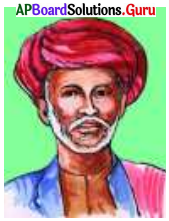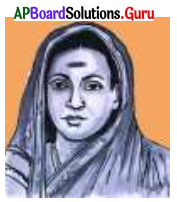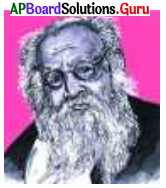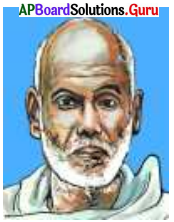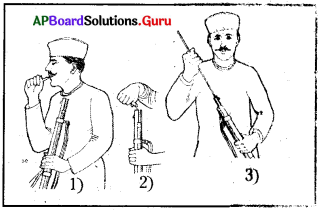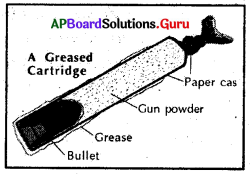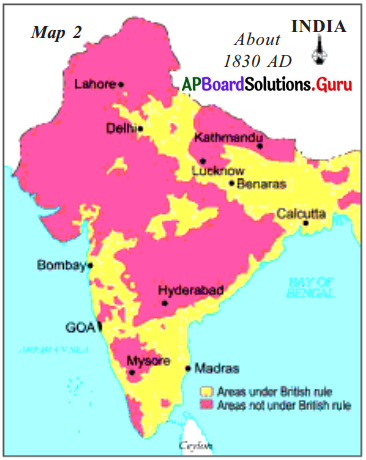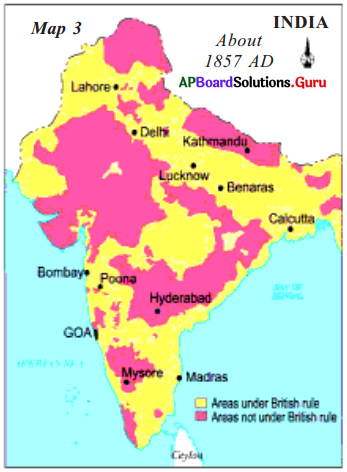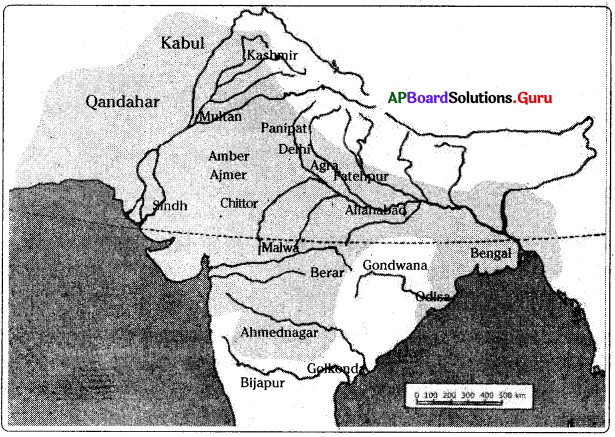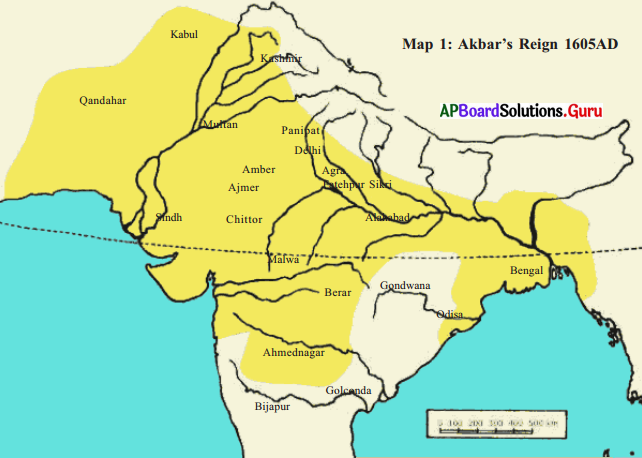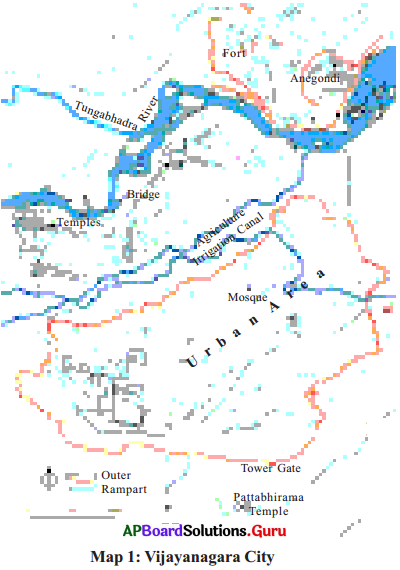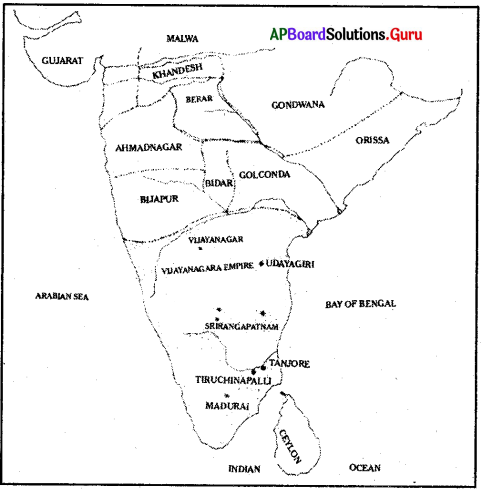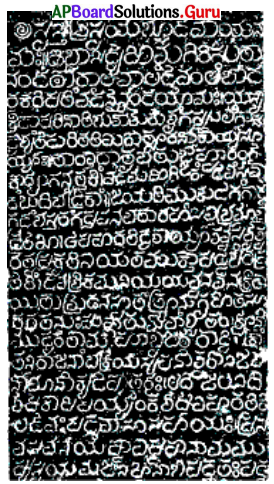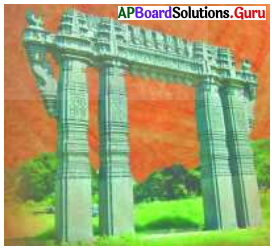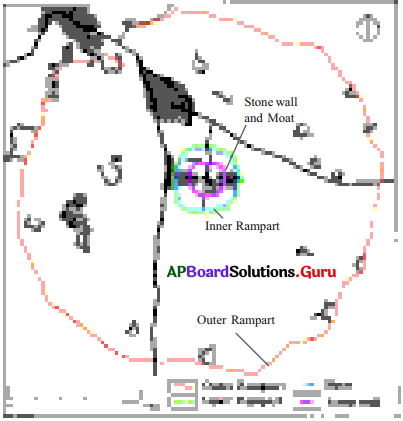AP State Syllabus 7th Class Social Important Questions 21st Lesson Devotional Paths to the Divine
Question 1.
What were the major ideas expressed by Basavanna?
Answer:
The connection between the bhakti movement and temple worship in turn to led to a reaction that was best represented in Virashaiva movement. It was initiated by Basavanna. This movement began in Karnataka in the mid twelfth century The major ideas expressed by Basavanna were,
- the Virashaivas argued strongly for the equality of all human beings.
- they were against scriptural ideas about the caste and the treatment of women.
- they were also against all forms of ritual and idol worship.
![]()
Question 2.
Discuss the ideas of the saints of Maharashtra?
Answer:
The ideas of the saints of the Maharashtra were :
- They rejected all forms of ritualism, outward display of piety and social differences based on birth.
- They rejected the idea of renunciation.
- They insisted that bhakti lay in sharing others’ pain.
Question 3.
Study the following table.
| Religious group | Their teachings and beliefs |
| Nathpanthis, Siddhas, and Yogis | 1) They criticized rituals and other aspects of conventional religion and social order. 2) They advocated renunciation of the world. 3) They believed salvation lay in meditation on the formless ultimate. 4) To achieve salvation they advocated intense training of the mind and the body through practices like yogasanas breathing exercises and meditation. |
| The saints of Maharashtra | 1) They rejected all forms of ritualism, outward display of piety. 2) They opposed social differences based on birth. 3) They rejected the idea of renunciation. 4) They insisted that bhakti lay in sharing others’ pain. |
| The Sufi saints | 1) The sufis rejected outward religiosity. 2) They emphasized love and devotion to God and compassion towards all fellow human beings. 3) They rejected the elaborate rituals and codes of behavior demanded by Muslim religious scholars. 4) They sought union with God. 5) They believed that the heart can be trained to look at the world in a different way. |
Now answer the following questions.
a. Write about the teachings and beliefs of Nathpanthis, Siddhas, and Yogis.
Answer:
- They criticized rituals and other aspects of conventional religion and social order.
- They advocated renunciation of the world.
- They believed that salvation lay in meditation on the formless ultimate.
- To achieve salvation they advocated intense training of the mind and the body through practices like yogasanas, breathing exercises, and meditation.
![]()
b. What were the prevalent religious and social beliefs opposed by the saints of Maharashtra?
Answer:
- The saints of Maharashtra rejected all forms of ritualism. The outward display of piety.
- They opposed social differences based on birth.
- They rejected the idea of renunciation.
c. What were the teachings of Sufi Saints?
Answer:
- The Sufis rejected outward religiosity.
- They emphasized love and devotion to God and compassion towards all fellow human beings.
- They rejected the elaborate rituals and codes of behavior demanded by Muslim religious scholars.
- They sought union with God.
- They believed that the heart can be trained to look at the world in a different way.
Question 4.
Study the following table.
| Name of the Saint | His teachings and beliefs |
| Basavanna | 1) He argued strongly for the equality of all human beings 2) He was against the scriptural ideas about caste and the treatment of women. 3) He was against all forms of ritual and ritual and idol worship. |
| Kabir | 1) He rejected the major religious traditions. 2) He openly ridiculed all forms of external worship of both Hinduism and Islam. 3) He ridiculed the pre-eminence of the priestly classes and caste system. 4) He believed in a formless Supreme God. 5) He preached that the only path to salvation was through bhakti or devotion. |
| Guru Nanak | 1) He emphasized the importance of worship of one God. 2) He insisted that caste, creed, or gender are irrelevant for attaining liberation. 3) He emphasized right worship, the welfare of others, and purity of conduct. 4) Guru Nanak’s idea of equality had social and political implications. |
a. What were the views of Basavanna, Kabir, and Gurunanak about the caste?
Answer:
Basavanna strongly argued for the equality of all human beings. Kabir ridiculed the pre-eminence of priestly classes and the caste system. Guru Nanak insisted that greed and gender are irrelevant for attaining liberation. Thus all the three saints criticized the caste in pits prevalent form and proposed suggestions to reform it.
![]()
b. Write about the religious beliefs of Basavanna, Kabir, and Guru Nanak?
Answer:
Basavanna was against all forms of rituals and idol worship Kabir openly ridiculed all forms of external worship of both the Hindus and Muslims. He believed in a formless Supreme God. He preached that the only path to salvation was through bhakti or devotion. Guru Nanak emphasized the importance of worship of one god.
c. What were the views of Kabir and Guru Nanak about liberation and salvation?
Answer:
Kabir preached that the only path to salvation was through bhakti or devotion. Nanak insisted that caste, creed, and gender are irrelevant for attaining liberation.
Question 5.
Study the following table.
| Name of the Saint | Lived in | Doctrine Propounded | Teachings |
| Ramanujacharya | 11th Century | Visishtadvaita or qualified monotheism | The best means of attaining salvation was through intense devotion to Vishnu. |
| Basavanna | Twelfth-Century | Virashaivism | Equality of all human beings and against scriptural ideas about caste and the treatment of women. He was against all forms of ritual and idol worship. |
| Kabir | Sixteenth Century | He ridiculed all forms of external worship of both Hinduism and Islam. He rejected the pre-eminence of priestly classes and the caste system. |
Now answer the following questions.
a. What was the doctrine propounded by Ramanuja?
Answer:
Visishtadvaita
b. Who propounded the doctrine of Virashaivism?
Answer:
Basavanna
![]()
c. Who advocated the equality of all human beings?
Answer:
Basavanna
d. Who criticized all forms of external worship of both Hinduism and Islam?
Answer:
Kabir
e. Who believed that the best means of attaining salvation was through intense\devotion of Vishnu?
Answer:
Ramanujacharya
Question 6.
Read the following passage.
Ramanujacharya born in South India in the eleventh century was deeply influenced by the Alvars. According to him the best means of attaining salvation was through intense devotion of Vishnu. Vishnu in His grace helps the devotee to attain the bliss of union with Him. Ramanuja also ensured a place for people of lower castes in temple worship. He propounded the doctrine of Vishishtadvaita or qualified oneness according to which the soul even when united with the Supreme God remained distinct. Ramanuja’s doctrine greatly inspired the new strand of bhakti, which developed in north India subsequently.
Now answer the following questions.
a. By whose teachings were Ramanujacharya influenced?
Answer:
Ramanujacharya was influenced by Alvar’s teachings.
b. What was the best means of attaining salvation according to Ramanujacharya?
Answer:
Intense devotion to Vishnu was the best means of attaining salvation according to Ramanujacharya.
c. What was the doctrine propounded by Ramanujacharya?
Answer:
Visishtadvaita.
d. What does Visishtadvaita means?
Answer:
Visishtadvaita means the soul even when united with the Supreme God remained distinct.
e. What is the other name of Visishtadvaita?
Answer:
Qualified oneness.
![]()
Question 7.
Read the following passage.
From the thirteenth to the seventeenth centuries Maharashtra saw a great number of saint-poets, whose songs in simple Marathi continue to inspire people. The most important among them were Jnaneshwar, Namdev, Eknath, and Tukaram as well as women like Sakkubai and the family of Chokhamela, who belonged to the “untouchable ” Mahar caste. This regional tradition of bhakti focused on the Vitthala (a form of Vishnu) temple in Pandharpur, as well as on the notion of a personal god residing in the hearts of all people.
Now answer the following questions.
a. In which language did the saints of Maharashtra preach their teachings?
Answer:
Marathi
b. Name some important saints of Maharashtra.
Answer:
Jnaneshwar, Namdev, Eknath and Tukaram, Sakkubai, and the family of Chokhamela.
c. Which saint of Maharashtra belonged to the untouchable Mahar caste?
Answer:
Chokhamela
d. What was the center of the Marathi Bhakti movement?
Answer:
Vithala
e. Which form of Vishnu is mentioned in the above passage?
Answer:
Vithala
Question 8.
Read the following passage.
Many religious groups of this period criticized the ritual and other aspects of conventional religion and the social order, using simple, logical arguments. Among them were the Nathpanthis, Siddhacharas, and Yogis. They advocated renunciation of the world. To them, the path to salvation lay in meditation on the formless Ultimate Reality and the realization of oneness with it. To achieve this they advocated intense training of the mind and body through practices like yogasanas, breathing exercises, and meditation. These groups became particularly popular among low castes. Their criticism of conventional religion created the ground for devotional religion to become a popular force in northern India.
Now answer the following questions.
a. What were the prevalent social and religious conditions criticized by the religious groups?
Answer:
The rituals and other aspects of conventional religion and the social order.
b. Name some religious groups that emerged during the medieval period.
Answer:
The Nathpanthis, Siddhacharas, and Yogis.
c. What was the path of salvation according to Siddhacharas?
Answer:
Meditation on the formless ultimate Reality and the realization of oneness With it.
d. What were the practices advocated by Siddhacharas to achieve salvation?
Answer:
Practices like Yogasanas breathing exercises and meditation are the methods advocated by Siddhacharas to achieve salvation.
e. What created the ground for devotional religion, a popular force?
Answer:
The criticism of conventional religion by Siddhacharas, Nathpanthis, and Yogis created the ground for devotional religion.
![]()
Question 9.
Read the following passage.
Like the saint-poets, the Sufis too composed poems expressing their feelings, and a rich literature in prose, including anecdotes and fables, developed around them. Among the great Sufis of Central Asia were Ghazzali, Rumi, and Sadi. Like the Nathpanthis, Siddhas, and Yogis, the Sufis too believed that the heart can be trained to look at the world in a different way. They developed elaborate methods of training using zikr (chanting of a name or sacred formula), contemplation, sama (singing), raqs (dancing), discussion of parables, breath control, etc. under the guidance of a master or pir. Thus emerged the silsilas, a genealogy of Sufi teachers, each following a slightly different method (tariqa) of instruction and ritual practice.
Now answer the following questions.
a. Write the names of great Sufi saints of Central Asia.
Answer:
Ghazzali, Rumi, and Sadi were the great Sufi saints of Central Asia.
b. Write at least two comparisons between the Sufis and Nathpanthis, Siddhas and Yogis.
Answer:
a) Like the Saint – poets the Sufis too composed poems expressing their feelings,
b) Like the Nathpanthis, Siddhas, and Yogis, the Sufis too believed that the heart can be trained to look at the world in a different way.
c. What were the methods developed by Suits to train the heart?
Answer:
Zikr, Contemplation, Sama, Raqs, discussion of parables, breath control, etc., were the methods developed by Sufis to train the heart.
d. What are silsilas?
Answer:
A genealogy of Sufi teachers.
e. Who guides the people in methods of training heart?
Answer:
Pir, the master guides the people in methods of training heart.
![]()
Question 10.
Read the following passage.
These saints – poets rejected all forms of ritualism, outward display of piety, and social differences based on birth. In fact, they even rejected the idea of renunciation and preferred to live with their families, earning their livelihood like any other person, while humbly serving fellow human beings in need. A new humanist idea emerged as they insisted that bhakti lay in sharing other’s pain. As the famous Gujarati saint Narsi Mehta said, “Vaishnavas are those who understand the pain of others”.
Now answer the following questions :
a. Who were the saint poets mentioned in the passage?
Answer:
The saint poets were Jnaneshwar; Namdevi, Eknath, and Tukaram.
b. What were the unscrupulous religious practices rejected by the saint poets?
Answer:
Expensive rituals, outward, display piety and social differences based on birth.
c. Were these saint poets complete Sanyasis?
Answer:
No. They did not renounce but they preferred to live with their families earning their livelihood like any other person.
d. What was the humanist idea that emerged during the times of saints?
Answer:
“To humble serve the fellow human beings in need’ was the humanist idea that emerged during the saints of poets.
e. Who was Narsi Mehta?
Answer:
A famous Gujarati saint.
Question 11.
What do you think were the existing religious and social conditions that caused the outbreak of the Bhakti movement?
Answer:
In the medieval period, society was under the burden of evil social practices such as casteism. Untouchability, the dominance of priestly class over the people of other castes. So the saints of Bhakti wanted to reform the society. Therefore they argued strongly for the equality of all human beings and questioned the relevance of scriptural ideas about the caste. There were so many unscrupulous religious beliefs challenged by the saints of Bhakti. Idol worship, polytheism evil aspects of conventional religion expensive rituals, external worship, pre-eminence of the priestly classes, orthodox customs and beliefs, outward display of piety were the unscrupulous religious practices the saints of Bhakti wanted to do away with.
These social and religious conditions caused the outbreak of the bhakti movement.
![]()
Question 12.
What were the prevalent social evils and unscrupulous religious beliefs the saints of bhakti wanted to be reformed?
Answer:
The social evils that the saints of bhakti wanted to reform are:
- untouchability and
- casteism.
Almost all the saints opposed casteism and they criticized social differences based on birth. They opposed the pre-eminence of the priestly classes. Thus the saints argued strongly for the equality of all human beings.
The prevalent unscrupulous religious beliefs challenged by the saints of bhakti were (a) Idol worship (b) rituals (c) outward display of piety (d) narrow and unscrupulous aspects of conventional religion (e) polytheism.
Question 13.
Visit any dargahs, gurudwaras, or temples associated with saints of the bhakti tradition and describe what you saw and heard about them.
Answer:
Student Activity.
![]()
Question 14.
Get information about other works of the saint-poets mentioned in this chapter. Sing those songs in your school programs.
Answer:
Student Activity.
